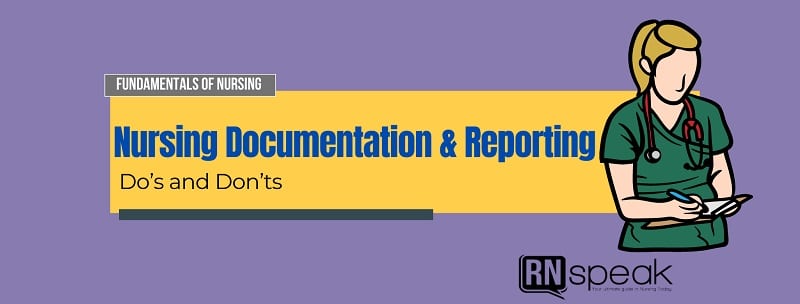Nursing documentation is responsible for keeping the legal record of the patient, which is known as the patient’s chart, regarding his personal information and care.
On the other hand, nursing reporting occurs when two medical professionals directly and indirectly involved in the care of the patient collaborate and exchange information about the care of the patient, either by personal or telephone conversation.
What are the functions of the patient’s chart?
1. Communication
It serves as a well-organized process of relaying necessary information from one care provider to another. It imparts important data about the patient’s condition.
2. Legal Documentation
It will serve as legitimate evidence used even in court.
3. Research
Health information provided which can be the basis for ongoing and future research
4. Statistics
It can be used as statistical data for health-related planning
5. Education
Health science students can utilize the facts for educational purposes
6. Review and Quality Assurance
The record can be utilized to assess the healthcare quality provided to the patient and the competency of the healthcare provider.
7. Preparation of Patient’s Care
The chart can be the source of information for the whole healthcare team to plan the patient’s care.
Good Features of Nursing Documentation and Recording
1. Concise
It is not necessary to use complete sentences in charting. For each entry, begin with a capital letter for the first letter of the initial word and end the statement with a period.
2. Permanence or Proper Usage of Ink
Use a ball pen when writing any information on the chart. Avoid using a felt pen or pencil.
3. Accurateness
State only the facts regarding the care. The healthcare provider’s opinions or interpretations are not necessarily included.
Example:
Correct: Consumed 2 Liters of water.
Incorrect: Drank plenty of water.
Additionally, use proper punctuation marks to quote the patient’s statement.
Example:
“I feel a stabbing pain in the center of my chest.”
It is important to include objective data.
Example:
Temp.=38.1ْ˚,PR=101bpm,RR=28bpm,BP=140/80mmHg,diaphoretic,skin warm to touch.
Behaviors are noted instead of the patient’s feelings.
4. Appropriateness
The important and relevant information is the only one noted in the chart.
5. Comprehensiveness and Correct Order
Charting entries should be uninterrupted and are only allowed to continue on another line if the entry is done at another time. Double charting is prohibited. Inserting additional data in-between spaces is also not allowed. Further information is entered on the first available line.
6. Usage of Standard Terminologies
| Abbreviation | Latin | English |
| a.c. | ante cebum | Before meals |
| ad.lib. | ad libitum | As desired |
| ADL | Activities of daily living | |
| ax. | Axillary | |
| bid | bis in die | Twice a day |
| BMR | Basal metabolic rate | |
| BP | Blood pressure | |
| c.c. | cum | With |
| cap | capsula | Capsule |
| gtt | gutta | Drop |
| h.s. | hora omni | Hours of sleep |
| IM | Intramuscular | |
| IV | Intravenous | |
| mcgtt | Microdrop | |
|
Once a day | |
| OD |
|
Right eye |
|
Every morning | |
| OS |
|
left eye |
| OU |
|
Both eyes |
| p.c. | post cebum | After meals |
| p.o. | per orem | By mouth |
| p.r.n. | pro re nata | As necessary |
| q.h. | quaque hora | Every hour |
| q.i.d. | quarter in die | Four times a day |
| s.s. | sine | Without |
| s.c. | sub cutem | Subcutaneously |
| ss. | semis | One-half |
| stat | statim | Immediately |
| tid | ter in die | Three times a day |
7. Properly Signed
Place the full name and status of the healthcare provider with a signature affixed on top of the name.
Example:
(Signature)
_____________________________Charity F. Marquez, R.N.
8. Avoid Errors
In case of an error, place a horizontal line over the wrong data. After this, place the word “error” on top of the mistake and affix the healthcare provider’s signature.
Example:
ERROR CM
BP=120/90mmHg BP=130/90mmHg
9. Legible Handwriting
Handwriting should be readable and clear for others to see.
10. Do not Leave Spaces
Place horizontal lines on spaces to avoid others from inserting additional data on the nurse’s notes.
11. Confidentiality
All information stated in the chart should be kept private.
Kinds of Nurse Records
Traditional Patient Record
The different individuals or departments involved in the patient’s care have allocated sections in the chart.
Parts:
- Admission Sheet
- Doctor’s Order Sheet
- Medical History
- Nurse’s Notes
- Other important reports and records ( laboratory findings, vital signs sheet, input and output sheet, referrals)
Problem Related Patient Record
The patient’s information are documented and organized in accordance to the origin of the data. The chart incorporates all the information regarding the problem as identified by the healthcare team.
Elements:
- Database
- List of Problems
- Preliminary Plan of Care
- Progress Notes
Nurse’s notes (SOAPIE of FDAR format)
- Flow Sheets
- Discharge Notes and Referral Summary
Kardex
It is an organized and concise sheet regarding the patient’s information and care used during endorsements. It is available to all the healthcare providers involved in the patient’s care.
Components:
- Demographic or personal information
- Basic needs
- Allergies
- Laboratory tests
- Daily nursing procedures
- Medications, intravenous fluids and blood transfusions
- Other treatments like suctioning, mechanical ventilation, oxygen therapy or dressing change
Kinds of Nursing Reporting
End of Shift Reporting or Endorsement
It is mainly done for continuity of care. Aside from the information stated in the Kardex, other important data regarding the patient’s care is also endorsed to the receiving team.
Telephone Reports
Telephone reports are usually brief and clear. This information should be included:
- Date and time call was made
- The name of the person who made the call
- The receiver of the call
- The receiver of the information
- The data are given
- The data received
- Telephone Order
Registered nurses are the only ones who can receive and process telephone orders. Telephone orders are validated by relaying the information clearly and accurately. This kind of order should be countersigned by the doctor who gave the order in no more than 24 hours.
Transfer Report
This type of reporting is done when a patient is transferred from one department to another.
Reference:
Quiambao-Udan,J.(2004). Mastering Fundamentals of Nursing. (2nd Ed.). Educational Publishing House.












